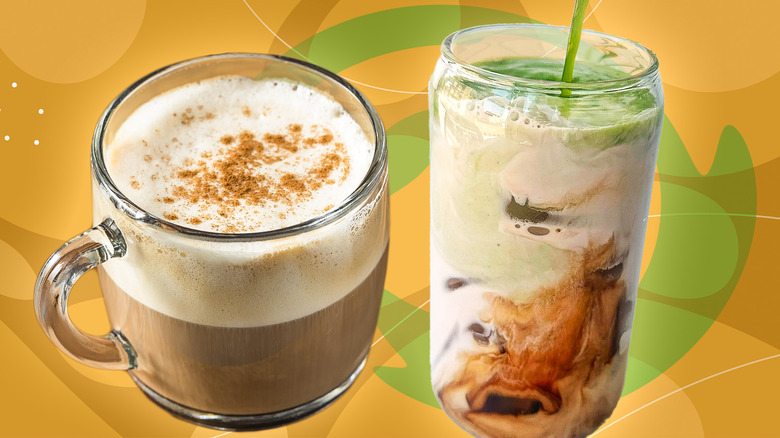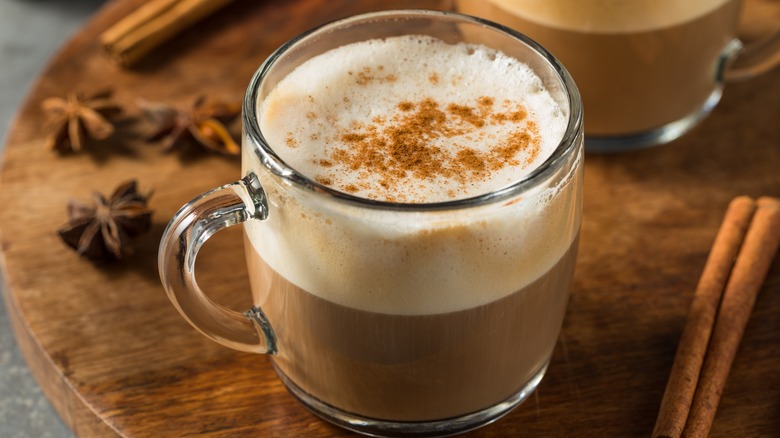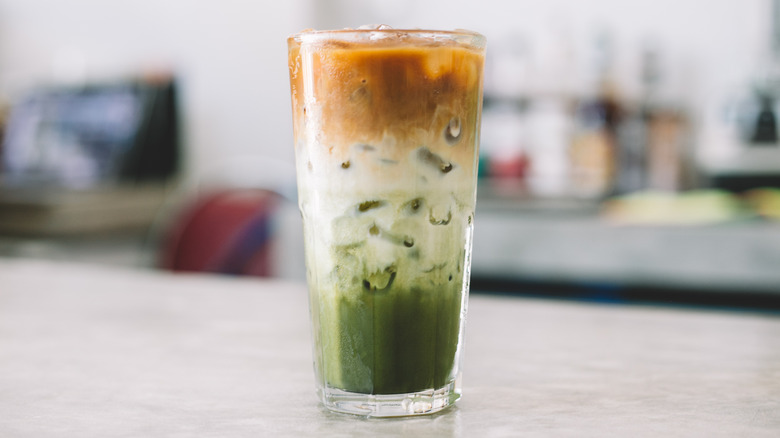Dirty Chai Vs Dirty Matcha: How Do These Coffee Concoctions Compare?
Ordering anything "dirty" (with a shot of espresso) at a cafe is a fun choice. It means you like to play with flavors, maybe can't decide between coffee and tea, and enjoy getting your daily espresso in no matter what. Dirty chai and dirty matcha are some of the more common "dirty" drinks you can find in a coffee shop. To make them, matcha and chai are both prepared normally, then rounded off with a shot or two of espresso.
So, how do these coffee drinks compare? Well, both are effectively caffeinating, can be served hot or cold, and feature a tea (matcha or chai) with espresso. Their differences — and likely your preferences — come down to their flavors and preparation methods. Chai is a spicy drink with warm flavors, while matcha is earthy and bright. Both complement the toasty, bitter taste of espresso in different ways. If you have a preexisting preference for chai or matcha, chances are you'll end up liking their respective dirty version the most, but both are worth a try. Dirty chai and dirty matcha cynics may say the espresso and tea flavors get muddled, but this "muddling" is what makes for a unique coffee concoction.
Dirty chai is warm and spiced
The dirty chai is rumored to be the accidental creation of an English barista in the '90s who made the delicious mistake of pouring a shot of espresso into a chai latte. The difference between dirty chai and regular is nothing more than the addition of espresso. Those who like the dirty version may enjoy other spiced coffee pairings, like coffee with a dash of cinnamon or pumpkin spice lattes.
In North America, what we call chai tea is actually masala chai, which roughly translates to "spiced tea" in Hindi. To make masala chai, warm spices like cinnamon, cardamom, star anise, and cloves are ground, added to water with black tea, and then boiled. Then comes milk and sugar, and a traditional method of "pulling" the tea involves ladling the tea out and slowly pouring it back in to make the beverage frothy. This preparation is not standard across cafes, but it's something to try if you want to make a warm and spicy chai recipe at home. At Starbucks, a TikTok hack for ordering a dirty chai latte involves simply ordering a latte with chai syrup — there is no actual tea, but the flavor is there.
It's worth noting that a dirty chai is more caffeinated than a regular latte. There are roughly 47 milligrams of caffeine in a cup of black tea, along with 63 milligrams of caffeine in a shot of espresso.
Dirty matcha has an earthy taste
The origins of the dirty matcha are also not fully known. It may have come from Japan, or it might be a product of a creative Starbucks order, but regardless, it has been a trendy beverage for the past few years. When espresso is poured over the top, dirty matcha has beautiful green and brown layers — it's a very photogenic drink. The milk bonds the matcha and espresso to create a subdued flavor with distinguishable grassy and bitter notes. Matcha is arguably easier to prepare at home than chai tea. An easy matcha latte recipe requires only matcha powder, water, milk of your choice, and optional sweeteners. If you're wondering if a matcha whisk is really necessary, it is. A matcha whisk (or milk frother at second best) is a crucial tool for de-clumping the matcha and making it smooth. It's ideal for all matcha drinks including dirty matcha.
Matcha is a type of green tea, and different green teas have varying amounts of caffeine. Since matcha is made from powdered green tea leaves, it's more strongly caffeinated than other green tea varieties. However, the amount and quality of matcha used can significantly alter its caffeine content to anywhere from roughly 76 to 178 milligrams of caffeine per cup. This amount, plus the espresso, can make a dirty matcha a good option for those who want to get more caffeine bang for their buck.


